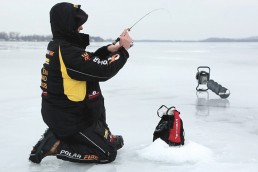When Negative Bites Become Positive
SHARE THIS POST
Tom Gruenwald shows you how to turn a negative bite into a positive catch!
The term “negative bites” is most often used to describe fish in shutdown mode. Dreaded days when fish get lockjaw. Outside-the-box thinking and refined techniques are required if we hope to achieve success.
However, that’s not the only definition of a negative bite. The second interpretation of the term is one used to describe a difficult-to-detect strike. A bite that most beginning and even many experienced ice anglers often miss.
It’s caused by a fish approaching a presentation from underneath, softly inhaling the bait and rising with it. Once recognized and understood, successful hook-ups are possible
Picture perfect
Many anglers turn to underwater cameras as a solution. Given the right conditions, this approach has proven effective by making it possible to witness such takes firsthand. In situations where underwater cameras aren’t appropriate, however, a fine-tuned presentation is required. The most reliable strategy involves careful monitoring of your sonar, combined with a consistent, repetitive jigging sequence.
When you see a fish approaching, continue the same repetitive jigging cadence. Turning your attention to the line, closely watch exactly how your lure responds to each movement. Now, remain intently focused. Lock in on that rhythm and fully trust your senses. If you notice any irregularity in that established motion—meaning the line suddenly tightens or, in the case of most negative bites, goes slack when not expected—set the hook!
Trust your instincts
Aggressive strikes are usually easily noted, to the point ice anglers with even minimal experience seldom miss one. When fish softly inhale the bait and move upward in the water column—especially if that fish is a wary panfish taking a light-jig fished on light line—you’ve just confronted a negative bite in its truest sense and will need much greater awareness if you want to consistently turn such takes into solid hooksets.
Unfortunately, being able to identify strikes using your line as an indicator often proves difficult, especially if you’re fishing outside, where environmental parameters such as gusty winds create interference by bowing your line or extreme temperatures cause ice build-up on your line as you jig.
Are you enjoying this post?
You can be among the first to get the latest info on where to go, what to use and how to use it!
In such instances, the best strike indicator is a neutrally buoyant float set completely underwater where it’s protected from the elements. This can be accomplished using micro shot sequenced from largest to smallest, painstakingly positioned so the float remains entirely submerged while suspending your bait at the precisely desired depth—typically just above where you’re marking suspended fish. If a fish moves in and even breathes on your bait, float movement will reveal the action, and do so without providing any significant resistance to the biting fish.
Hitting rock bottom
When fish are holding tight to bottom, another way to achieve a similar result is by using a tiny slip sinker and super-thin, elongated, quill-tipped slip bobber pinned between a pair of line stoppers. Set it so when your bait is resting directly on bottom, the float is positioned at the desired distance beneath the surface. If a fish so much as nudges your bait, line will slide through the slip sinker. This will cause the float to twitch ever-so-slightly, alerting you to the hit. The fish won’t feel a thing until the point of your hook sinks home.
Provided outside conditions are favorable or you’re fishing inside where there’s no wind and little or no ice is forming on the water’s surface, your float or line, a third effective way to detect a negative bite is using a neutrally buoyant, well-balanced balsa float. This time, position it with its tip just sticking out above the water. Again, this can be accomplished using precisely weighted micro shot set. These sets easily register negative bites by either tipping slightly to the side or slipping gently under the surface when even the wariest fish tastes your bait.
If you’re not into floats and fishing in the right conditions, negative bites can also be recognized using thin-tipped micro rods featuring small, light, precisely balanced eyes and super-fast action tips that will move at the slightest inclination. This setup is also quite versatile, as adjusting the depth of your presentation is simple as raising or lowering your rod.
Such rods can be used to establish a jigging cadence, and your eyes can be trained to identify aberrations causing that tip to unexpectedly dip, rise—or, when using a subtle shivering type motion, suddenly stop moving—thereby revealing a negative bite.
Catching negative bites with ease
Using these types of rods in conjunction with the ability to watch line is an absolute killer way to detect negative bites. Known in some circles as “tight-lining,” those who master this method often catch fish when others swear they’re not biting.
Once you know negative bites occur, and how, you can begin to effectively use the right types of equipment, tactics and techniques necessary to properly detect and respond.
Even a seasoned outdoorsman can learn something new. Check out the winter issues of MidWest Outdoors, available at the newsstand or by subscribing on our website.
MWO
SHARE THIS POST
You may also like...
Nothing found.
Did you enjoy this post?
You can be among the first to get the latest info on where to go, what to use and how to use it!
Tom Gruenwald
Tom Gruenwald has penned hundreds of informative ice-fishing articles and blogs, been a frequent and popular guest on outdoor speaking circuits, radio and television, has authored four ice-fishing books, and formerly hosted Tom Gruenwald Outdoors, a nationally syndicated television show dedicated solely to the sport of ice-fishing.
